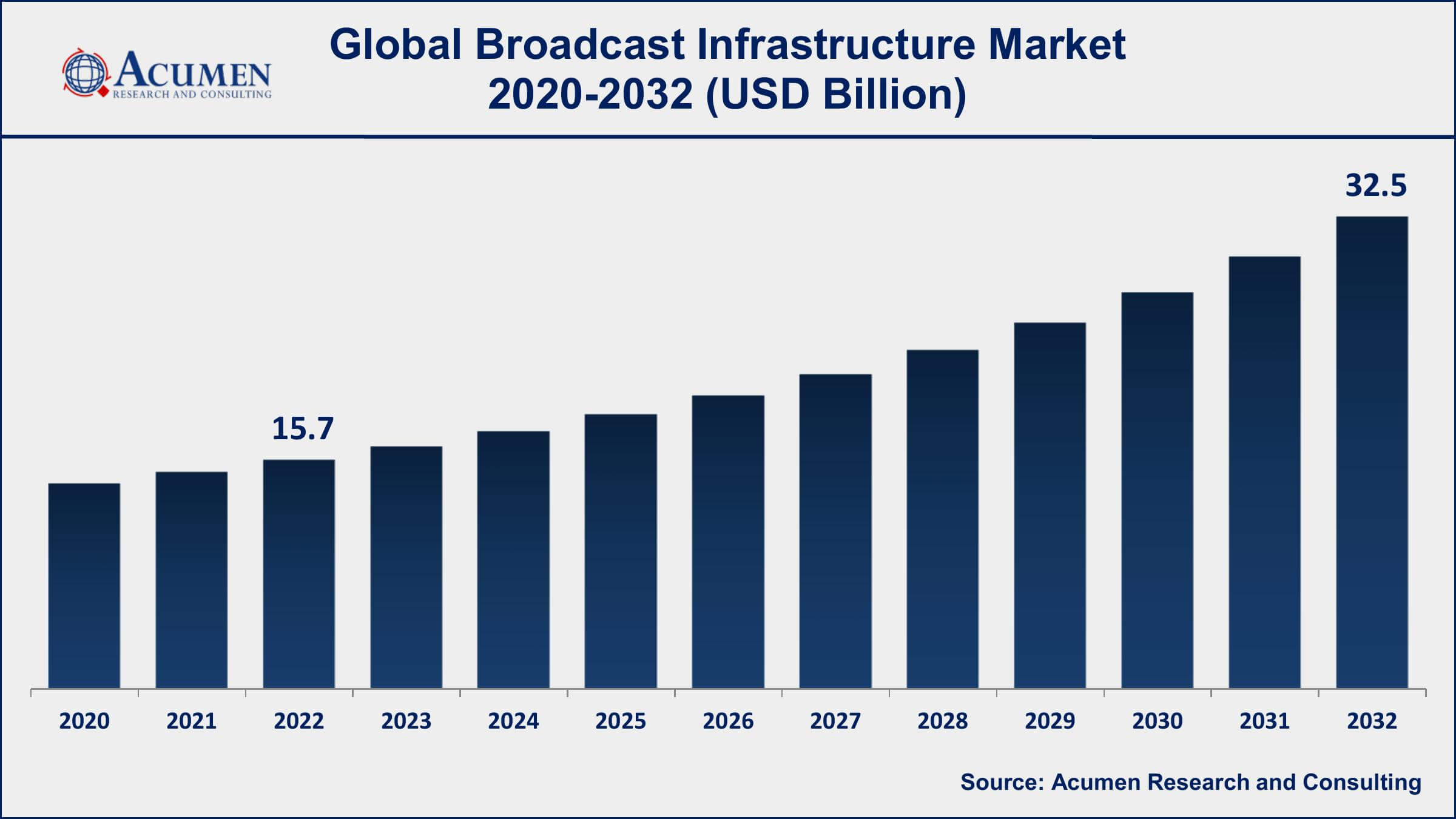Broadcast Infrastructure Market Size - Global Industry, Share, Analysis, Trends and Forecast 2023 - 2032
Published :
Report ID:
Pages :
Format :
Broadcast Infrastructure Market Size - Global Industry, Share, Analysis, Trends and Forecast 2023 - 2032
Report Coverage
- Industry Dynamics
- Market Size and Forecast Data
- Segment Analysis
- Competitive Landscape
- Regional Analysis with a Niche Focus on Country-Level Data
- High Level Analysis - Porter's, PESTEL, Value Chain, etc.
- Company Profiles of Key Players
- Option to Customize the Report As Per Your Specific Need
Request Sample Report
The Global Broadcast Infrastructure Market Size accounted for USD 15.7 Billion in 2022 and is projected to achieve a market size of USD 32.5 Billion by 2032 growing at a CAGR of 7.7% from 2023 to 2032.
Broadcast Infrastructure Market Highlights
- Global Broadcast Infrastructure Market revenue is expected to increase by USD 32.5 Billion by 2032, with a 7.7% CAGR from 2023 to 2032
- North America region led with more than 33% of Broadcast Infrastructure Market share in 2022
- Asia-Pacific broadcast infrastructure market growth will record a CAGR of more than 8.3% from 2023 to 2032
- According to a Deloitte report, 82% of US customers would have subscribed to at least one streaming video service by 2021, with an average of four subscriptions per household
- By component, the software segment has accounted more than 47% of the revenue share in 2022
- Increasing demand for high-quality and on-demand content, drives the Broadcast Infrastructure Market value

Broadcast infrastructure refers to the technological framework and equipment necessary for the transmission and distribution of audio and video content over various media platforms, including television, radio, and the internet. It encompasses a wide range of components, such as signal processing and encoding systems, transmission networks, storage solutions, content management systems, and broadcast servers. The broadcast infrastructure plays a crucial role in ensuring seamless and efficient delivery of media content to audiences worldwide.
The broadcast infrastructure market has experienced significant growth in recent years due to the increasing demand for high-quality, on-demand content and the shift towards digital broadcasting. The proliferation of digital platforms and the advent of advanced technologies like high-definition (HD) and ultra-high-definition (UHD) have propelled the need for robust and scalable infrastructure solutions. Additionally, the rise of Over-The-Top (OTT) services, video streaming platforms, and the convergence of broadcasting and internet technologies have further fueled the market's expansion. Furthermore, the growing number of broadcasting channels, the emergence of new content formats such as 4K and 8K, and the need for efficient content management and distribution workflows have created a demand for innovative infrastructure solutions.

Global Broadcast Infrastructure Market Trends
Market Drivers
- Increasing demand for high-quality and on-demand content
- Shift towards digital broadcasting and migration from analog to digital transmission
- Proliferation of digital platforms and the rise of Over-The-Top (OTT) services
- Advancements in technology, such as high-definition (HD) and ultra-high-definition (UHD) formats
- Convergence of broadcasting and internet technologies
Market Restraints
- High initial investment costs associated with infrastructure upgrades and deployment
- Complex regulatory frameworks and licensing requirements in some regions
- Challenges related to interoperability and compatibility between different infrastructure components
Market Opportunities
- Growing adoption of cloud-based broadcast platforms for scalability and flexibility
- Increasing demand for multi-platform content delivery, including mobile and smart devices
- Expansion of 5G networks enabling faster and more reliable content transmission
Broadcast Infrastructure Market Report Coverage
| Market | Broadcast Infrastructure Market |
| Broadcast Infrastructure Market Size 2022 | USD 15.7 Billion |
| Broadcast Infrastructure Market Forecast 2032 | USD 32.5 Billion |
| Broadcast Infrastructure Market CAGR During 2023 - 2032 | 7.7% |
| Broadcast Infrastructure Market Analysis Period | 2020 - 2032 |
| Broadcast Infrastructure Market Base Year | 2022 |
| Broadcast Infrastructure Market Forecast Data | 2023 - 2032 |
| Segments Covered | By Component, By Technology, By End User, And By Geography |
| Regional Scope | North America, Europe, Asia Pacific, Latin America, and Middle East & Africa |
| Key Companies Profiled | Cisco Systems Inc., Ericsson, Harmonic Inc., Huawei Technologies Co. Ltd., Imagine Communications, NEC Corporation, Evertz Microsystems Ltd., Grass Valley, ARRIS International plc, ATEME, Rohde & Schwarz GmbH & Co. KG, and Snell Advanced Media Ltd. (SAM). |
| Report Coverage |
Market Trends, Drivers, Restraints, Competitive Analysis, Player Profiling, Covid-19 Analysis, Regulation Analysis |
Broadcast infrastructure refers to the underlying framework and systems that enable the transmission and distribution of audiovisual content to a large audience. It encompasses various technologies, equipment, and networks required for broadcasting, such as satellite systems, terrestrial transmitters, cables, antennas, and data centers. Broadcast infrastructure plays a crucial role in delivering television and radio programming, as well as other multimedia content, to viewers and listeners worldwide.
One of the key applications of broadcast infrastructure is in traditional television and radio broadcasting. TV and radio stations rely on a complex network of infrastructure components to capture, process, encode, transmit, and distribute their content to a broad audience. This infrastructure includes studio facilities, production equipment, broadcasting towers, transmission lines, and satellite uplink/downlink systems. By utilizing broadcast infrastructure, media organizations can reach a large number of viewers and listeners simultaneously, ensuring widespread access to news, entertainment, educational programs, and other content.
The broadcast infrastructure market has been experiencing significant growth over the past few years and is expected to continue its upward trajectory in the coming years. The increasing demand for high-definition content, the rapid expansion of digital media, and the emergence of over-the-top (OTT) platforms are some of the key factors driving the growth of this market. One of the primary drivers of the broadcast infrastructure market is the growing consumer preference for high-quality video content. With the increasing popularity of high-definition and ultra-high-definition televisions, broadcasters and content creators are under pressure to deliver superior visual experiences to viewers. This has led to a higher demand for advanced broadcast infrastructure solutions that can support the production, management, and distribution of high-quality content.
Broadcast Infrastructure Market Segmentation
The global Broadcast Infrastructure Market segmentation is based on component, technology, end user, and geography.
Broadcast Infrastructure Market By Component
- Hardware
- Software
- Services
According to the broadcast infrastructure industry analysis, the software segment accounted for the largest market share in 2022. This growth due to the increasing need for advanced software solutions that enable efficient content creation, management, and distribution. The rapid digital transformation of the broadcast industry and the rising demand for personalized and interactive content are key drivers behind this growth. One of the significant factors contributing to the growth of the software segment is the adoption of cloud-based software solutions in broadcasting. Cloud-based software offers broadcasters and content creators the flexibility and scalability required to handle large volumes of content and deliver it seamlessly to various platforms and devices. It enables efficient content storage, transcoding, and distribution, thereby streamlining the overall broadcast workflow.
Broadcast Infrastructure Market By Technology
- Analog Broadcasting
- Digital Broadcasting
In terms of technologys, the digital broadcasting segment is expected to witness significant growth in the coming years. This growth due to the ongoing transition from analog to digital broadcasting formats. The advantages offered by digital broadcasting, such as improved picture and sound quality, increased channel capacity, and interactive features, are driving the adoption of digital broadcasting infrastructure across the globe. One of the key factors driving the growth of the digital broadcasting segment is the government initiatives and regulations promoting the transition to digital broadcasting. Many countries have set deadlines for the complete switch-off of analog signals, thereby compelling broadcasters to invest in digital infrastructure. This transition allows broadcasters to optimize spectrum utilization, provide a broader range of channels, and offer innovative services to viewers.
Broadcast Infrastructure Market By End User
- OTT
- Cable
- Terrestrial
- Satellite
- IPTV
According to the broadcast infrastructure market forecast, the OTT segment is expected to witness significant growth in the coming years. OTT platforms deliver content directly to viewers over the internet, bypassing traditional broadcast channels. The convenience, flexibility, and personalized content offerings of OTT services are key drivers behind the growth of this segment. One of the primary factors driving the growth of the OTT segment is the increasing consumer preference for on-demand content. Viewers are increasingly shifting away from traditional scheduled programming and embracing the flexibility of accessing their favorite movies, TV shows, and other video content at their convenience. OTT platforms cater to this demand by providing a vast library of on-demand content, allowing viewers to watch what they want, when they want.
Broadcast Infrastructure Market Regional Outlook
North America
- U.S.
- Canada
Europe
- U.K.
- Germany
- France
- Spain
- Rest of Europe
Asia-Pacific
- India
- Japan
- China
- Australia
- South Korea
- Rest of Asia-Pacific
Latin America
- Brazil
- Mexico
- Rest of Latin America
The Middle East & Africa
- South Africa
- GCC Countries
- Rest of the Middle East & Africa (ME&A)

Broadcast Infrastructure Market Regional Analysis
North America dominates the broadcast infrastructure market for several reasons, including its advanced technological infrastructure, strong media and entertainment industry, and early adoption of digital broadcasting and OTT platforms. These factors have contributed to the region's dominance in the market. North America benefits from its robust technological infrastructure. The region has a well-established network of telecommunications and broadband connectivity, which provides a strong foundation for the delivery of broadcast content. This infrastructure enables seamless transmission and distribution of high-quality video and audio signals, supporting the growth of the broadcast infrastructure market. Moreover, North America has a thriving media and entertainment industry. The region is home to major broadcasters, content creators, and production studios, leading to a high demand for advanced broadcast infrastructure solutions. The presence of influential media companies, such as Hollywood studios, drives innovation and investment in cutting-edge technologies and infrastructure, making North America a focal point for the development and deployment of broadcast infrastructure solutions.
Broadcast Infrastructure Market Player
Some of the top broadcast infrastructure market companies offered in the professional report include Cisco Systems Inc., Ericsson, Harmonic Inc., Huawei Technologies Co. Ltd., Imagine Communications, NEC Corporation, Evertz Microsystems Ltd., Grass Valley, ARRIS International plc, ATEME, Rohde & Schwarz GmbH & Co. KG, and Snell Advanced Media Ltd. (SAM).
Frequently Asked Questions
What was the market size of the global broadcast infrastructure in 2022?
The market size of broadcast infrastructure was USD 15.7 Billion in 2022.
What is the CAGR of the global broadcast infrastructure market from 2023 to 2032?
The CAGR of broadcast infrastructure is 7.7% during the analysis period of 2023 to 2032.
Which are the key players in the broadcast infrastructure market?
The key players operating in the global market are including Cisco Systems Inc., Ericsson, Harmonic Inc., Huawei Technologies Co. Ltd., Imagine Communications, NEC Corporation, Evertz Microsystems Ltd., Grass Valley, ARRIS International plc, ATEME, Rohde & Schwarz GmbH & Co. KG, and Snell Advanced Media Ltd. (SAM).
Which region dominated the global broadcast infrastructure market share?
North America held the dominating position in broadcast infrastructure industry during the analysis period of 2023 to 2032.
Which region registered fastest CAGR from 2023 to 2032?
Asia-Pacific region exhibited fastest growing CAGR for market of broadcast infrastructure during the analysis period of 2023 to 2032.
What are the current trends and dynamics in the global broadcast infrastructure industry?
The current trends and dynamics in the broadcast infrastructure industry include increasing demand for high-quality and on-demand content, shift towards digital broadcasting and migration from analog to digital transmission, and proliferation of digital platforms and the rise of Over-The-Top (OTT) services.
Which technology held the maximum share in 2022?
The digital broadcasting technology held the maximum share of the broadcast infrastructure industry.



